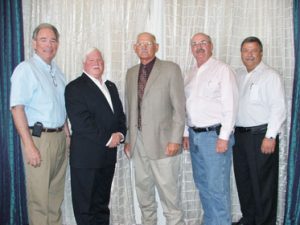Highlights from Galveston
The North & East Texas County Judges and Commissioners Association welcomed Chambers, Galveston and Orange counties into the region following the passage of a resolution at the Association’s annual conference in Galveston May 20-23, bringing the new membership total to 72 counties.
Some 175 officials gathered at Moody Gardens in Galveston County, where commissioners court members discussed key issues affecting county government and conducted Association business, passing a total of seven resolutions and electing the 2012-2013 slate of officers.
Capitalizing on the conference theme “Navigating the Winds of Change,”  officials looked toward the 83rd Texas Legislature, set to convene Jan. 8, 2013, and run 140 days, through May 27 (see important dates, page ?).
officials looked toward the 83rd Texas Legislature, set to convene Jan. 8, 2013, and run 140 days, through May 27 (see important dates, page ?).
“For the first time in history, the majority of the House of Representatives will be freshmen or sophomores,” said Jim Allison, general counsel of the County Judges and Commissioners Association of Texas (CJCAT). “The education and communication job we have will be twice as heavy…it’s a never-ending process.”
During the Opening General Session, Allison teamed up with Polk County Judge John Thompson, 2011-12 North & East president and chair of the CJCAT Legislative Committee, and Paul Sugg, director of the Texas Association of Counties (TAC) Legislative Department, for a presentation on Working with the Legislature.
The recent census and consequential redistricting led to a continuation of an urban vs. rural trend, with representation shifting more to the urban areas, Allison explained.
“A major part of our job in preparing for the legislative session is seeking out our urban members, along with our rural members, and educating them,” he reported.
Key issues to discuss with all lawmakers, especially the novice members, include:
- Retention of funds already dedicated to counties and county-related programs. The impending budget shortfall will once again mean the “temptation to take dedicated funds and sweep them into the state budget,” Allison emphasized. In fact, the state has become “addicted” to dedicated funds, Sugg echoed.
- The tendency to pass unfunded mandates, and the detrimental effects of these mandates on county government. “Every unfunded mandate starts out as somebody’s good idea,” Allison stated. “We spend a great deal of our time each legislative session fighting these mandates.”
Representatives and senators, especially those with limited experience, may not – and likely do not – fully understand these and other issues faced by commissioners courts, Thompson maintained, so “make sure you go back home and get to know them.”
While change is on the horizon at the capitol, counties continue to face change at the local level, whether it be explosive growth due to the oil boom, population decline and diminishing tax base, or the inevitable need to replace buildings and infrastructure. These changes oftentimes necessitate planning ahead.
“What does it mean to prepare for change?” asked Allison during a class on strategic planning. “It means getting ready before the event.”
Allison explored strategic planning through the lens of interlocal agreements, which specifically authorize counties and other political subdivisions to contract with one another for the performance of governmental functions under terms prescribed by the Legislature.
“The Interlocal Cooperation Act has been enthusiastically embraced by Texas counties, and most counties have adopted multiple contracts under its provisions,” Allison declared. For example, these agreements have been prepared for law enforcement services, tax collection, payroll, personnel and administrative services, jail inmate medical services, highway projects, emergency medical services, regional public defender projects, and fire protection services.
“These interlocal agreements have become an integral part of county strategic planning,” Allison stated, allowing commissioners courts to provide services within budgetary limits and stretch their funding.
Until recently interlocal agreements have been limited to short-term strategic planning, due to a legislative “public debt” provision requiring any obligation of a city or county to be payable from current funds. Thanks to new legislation and approval of a constitutional amendment passed by voters on Nov. 8, 2011, counties may now enter into extended-term interlocal contracts with cities.
Allison reminded officials of two key factors when it comes to these extended agreements: First, the contract must have a definite term; “whether two years or 200 hundred years is a matter of negotiation, and it may be renewed,” he explained.
Second, the Legislature has not waived the defense of governmental immunity for agreements involving real estate, meaning if real property or buildings will be involved in the extended interlocal agreement, “to be enforceable in court it should include a waiver of the defense of governmental immunity,” Allison underscored. (For additional information on interlocal agreements, see page ?.)
The Closing General Session included a class on a major change facing Texas counties: the Health Care Transformation and Quality Improvement Program 1115 Waiver, or simply the 1115 Waiver.
In December 2011, Texas received approval from the Centers for Medicare and Medicaid Services (CMS) for this waiver that allows the state to expand Medicaid managed care while preserving hospital funding, provides incentive payments for health care improvements, and directs more funding to hospitals that serve large numbers of uninsured patients. The waiver replaces the current Upper Payment Limit (UPL) program and will be in effect until September 2016.
For the first year, no change was required for hospitals, as they continued receiving funding as they had under the UPL program. Starting October 2012 (the second year), any entity that wants to continue with or begin participating in the waiver programs must engage in development and transition activities. This participation is a requirement for funding eligibility at any time in the waiver program.
Under the waiver, there are two funding pools – the Uncompensated Care (UC) pool, and the Delivery System Reform Incentive Payment (DSRIP) pool. As in the UPL program, receipt of funding from either pool requires a state match.
UC Pool Payments are designed to help offset uncompensated care costs provided by the hospital or other providers to Medicaid-eligible or uninsured individuals. To qualify for a UC payment, a hospital must submit an annual UC application providing cost and payment data on services eligible for reimbursement.
Uncompensated care amounts will be based on:
- Uncompensated Medicaid costs and uninsured patients’ costs not covered by disproportionate share hospital.
- Medicaid non-hospital uncompensated care costs (such as physician, clinic, and pharmacy defined by the UC Application).
DSRIP Pool Payments are hospital incentive payments to develop qualifying programs or strategies supporting hospitals’ efforts to enhance access to health care and increase quality of care, cost-effectiveness of care provided, and the health of patients and families served. Programs or strategies eligible for incentive payments must be included in plans submitted to the state.
Eligibility to receive payments from either of these funding pools will require participation in a Regional Healthcare Partnership (RHP). Entities providing Intergovernmental Transfer (IGT) funding will work with other IGT-providing entities in geographical regions as Regional Healthcare Partnerships (RHPs). The RHP regions will be developed throughout the state. Each RHP is required to submit a RHP plan for the last four years of the waiver (October 2012 to September 2016) as a funding requirement.
“Look in your budget and figure out what you’re already doing and how you can leverage more federal dollars,” said Rick Thompson, senior legislative liaison with TAC. “The ‘home run’ here may be mental health diversion programs and ambulances services,” he continued. “See if you can take money already coming out of your budget and give it leverage.”
The 1115 Waiver concept is admittedly complex, and “communication throughout this process is going to be very important,” Thompson reiterated. TAC has developed a webpage specifically dedicated to the 1115 Waiver: http://www.county.org/resources/legis/medicaid1115/index.asp. (See the recently released 1115 Waiver Regional Partnership Map and Anchor Designations, page ?.)
While North & East conference attendees spent the majority of their time in the classroom studying these and other key issues, the four-day meeting provided plenty of opportunity to enjoy Moody Gardens and Galveston attractions. The Pyramid Garden Lobby played host to a well-attended Vendor Appreciation Dinner, where guests also were invited to the Rainforest and Discovery pyramids.
Host Court Night at the Lone Star Flight Museum included a catered dinner and tours of vintage World War II Aircraft. Golf, domino, fishing and Texas Hold’em tournaments rounded out the entertainment, giving officials the opportunity to renew old friendships and make new acquaintances.
The conference adjourned with the President’s Luncheon and Installation of Officers, where the membership thanked Association President and Polk County Judge John Thompson for his years of dedicated service, and then welcomed incoming President and Jasper County Commissioner Charles Shofner (see new officers listing, page?).
The North & East Texas County Judges and Commissioners Association 2013 Annual Education Conference and Business Meeting will take place July 7-11 at La Torretta Lake Resort and Spa (formerly Del Lago) in Montgomery. County Progress will publish registration details in our County Calendar as they become available. H – By Julie Anderson
















